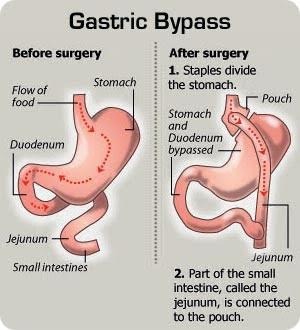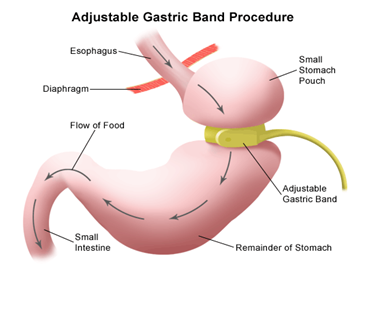Weight gain has become like a disease throughout the whole world. You can gain weight for many reasons. But if you want to go for a weight loss surgery, then you have to find out whether you are the right candidate for it or not?
1) Efforts to lose weight with diet and exercise have been unsuccessful
2) You are suffering from extreme obesity as your body mass index (BMI) is 40 or higher
3) You are suffering from obesity as your BMI is 35 to 39.9 and you have a serious weight-related health problem, such as type 2 diabetes, high blood pressure or severe sleep apnea
4) You are more than 100 lbs. over your ideal body weight.
1) Gastric Bypass surgery– Also called as “Roux-en-Y” gastric bypass, or RYGB, this is one of the common procedures for weight loss surgery. It combines both restrictive and malabsorptive approaches. Here, the stomach is divided into two parts, sealing off the upper section from the lower.

The surgeon connects the upper stomachcalled the pouch directly to the lower section of the small intestine.The pouch can’t hold a lot of food, resulting in eating less. The food then bypasses the rest of the stomach, going straight from the pouch to the small intestine.
2) Adjustable Gastric Banding – This is a type of restrictive weight loss surgery. A small band is put around the top of the stomach. The band has a small balloon inside controlling how tight or loose the band is. A very small channel connects the two sections which slows down the emptying of the upper pouch.

This operation is simpler than that of gastric bypass and other weight loss procedures. Here the recovery is faster and the band can be removed by surgery.
The band can also be adjusted with the help of doctor. To tighten the band and further restrict the stomach size, more saline solution is injected into the band. To loosen it, liquid is removed from the band with the help of the needle. The whole surgery is done with the help of a laparoscope.
3) Gastric Sleeve surgery– This is another form of restrictive weight loss surgery. In the operation, about 75% of the stomach is removed. A narrow tube or sleeve of the whole stomach is left, which connects to the intestines. Sometimes, a sleeve gastrectomy is the first step in a series of weight-loss surgeries. For some people, it’s the only surgery they need.

A sleeve gastrectomy is a simpler and lower risky operation to lose weight. As the intestines aren’t affected, a sleeve gastrectomy doesn’t affect how the body absorbs food, so it is less likely to fall short on nutrients.The surgery may also curb the hunger hormone ghrelin, which results in eating less.
4) Duodenal Switch – The duodenal switch is a type of combined malabsorptive and restrictive weight loss surgery. The surgery begins with multiple half-inch long incisions in the area of the stomach and middle of the abdomen.

The stomach remains attached to the first segment of the small intestine, the duodenum, which is then separated from the rest of the small intestine. The duodenum is then attached to the lowest part of the small intestine, bypassing the majority of the second and third segments of the small intestine.
The surgeon determines that there are no areas that are leaking, and then the instruments are withdrawn and the incisions are closed, typically with absorbable sutures or sterile tape.
Duodenal switch surgery has excellent results, with the average patient losing 70 to 80% of his excess weight in the two years that follow the procedure. However, patients who choose this type of surgery are at much higher risk for nutritional deficiencies than with other types of weight loss surgery.
The weight loss surgery acts as an effective tool to provide with long term weight-loss resulting in increase of quality of health. These surgeries have also acted as a means to improve or resolve many obesity-related conditions, such as type 2 diabetes, high blood pressure, heart disease, and more.
Adding to improving health and longevity, surgical weight-loss also improves overall quality of life, which includes physical functions such as mobility, self-esteem, work, social interactions.




Cancer Treatment in India, VSD Closure (Ventricular Septal Defect), ASD Closure Surgery (Atrial Septal Defect), Heart hole closure surgery in india, Brain Tumour Surgery in India, Craniotomy Surgery for Treatment of Brain Tumour in India, Brain Stem Glioma Treatment in India, Deep Brain Stimulation surgery in india , Best Spine Surgery In India , Cervical Spine Disorders Surgery and Treatment in india , epilepsy surgery in india , Heart Surgery in india , Best open heart surgery hospital in India , All about Spine Surgery, Types of Back Surgery , Top Doctors In India , Best Hospitals in India , Bhavin Desai cardiac surgeon, Best kidney transplant doctor in IndiaBest hospital for limb lengthening surgery in India, Best hospital for neurosurgery in India, Best hospital for bypass surgery in India, Narayana Hrudayalaya online appointment, Best orthopedic hospital in Bangalore, Best open heart surgery hospital in India, Best bypass surgeon in India, best spine surgery hospital in India, Artemis hospital Gurgaon, KD hospital medical appointment
Limb lengthening surgery cost in India, DSA test, Diabetes treatment in India